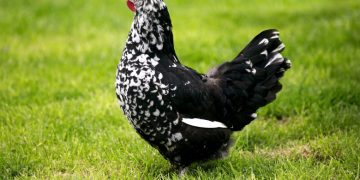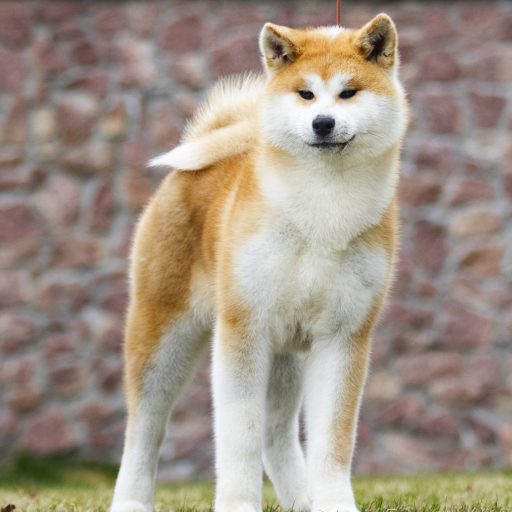Difficult to miss the Gournay and its atypical so-called stony plumage. This rustic hen from the French terroir comes, as its name suggests, from Gournay-en-Bray, in Seine-Maritime. A good layer, this ancient breed practically disappeared after the war, to be rehabilitated in the 90s by several associations. A dwarf Gournay breed also exists. Just as elegant as its larger cousin, it is a perfect ornamental hen.
Physical peculiarities
The Gournay has a very elongated body horizontally as if the crop were overdeveloped. She carries her tail high, square to her back. Note that with the years and successive moults, its plumage tends to whiten, giving it an increasingly pronounced salt and pepper appearance.
Egg size: 55/60g, white shell.
Plumage: black spotted with white. Plumage that is said to be “pebbly”.
Eyes: orange-yellow irises.
Beak: small, arched, mixture of white, pink and black.
Crest: simple, straight, fairly large span behind.
Chest: wide and deep, giving it a rounded shape.
Mumps: white, sometimes with small touches of red.
Tarsi: rather short, black mottled with pink. Four toes.
Behavior and character
Easy to raise, the Gournay hen is of very good composition and not shy for a penny. She turns out to be a wonderful pet who does not hesitate to come to you and show you tenderness. It is not however a pullet that can do without its living space, the Gournay likes to live in the open air and can not stand being cramped in its henhouse. She enjoys the company of other chickens and barnyard animals, but you don’t have to introduce her to companions. Unlike other breeds, such as the Harco, the Gournay hen can live very well alone or in pairs.
Feed
No particular recommendation for the Gournay diet. This ancient breed has always been able to do with the means at hand.
If you want your casserole good eggs, remember that his diet must be rich in protein. In case you do not opt for classic pellets for layers, make sure to supplement its cereal diet with protein peas, barley or oats.
Reproduction
La Gournay is a fairly precocious layer that reaches fertility around 3 months. It is not a good brooder, it will be very difficult to build a floor by yourself with this pullet. This is surely one of the factors that led to its near extinction. Some Gournays can incubate with practice, but bet on an electric incubator if you want to be sure of seeing chicks born.
Health
As a good local hen, the Gournay does not suffer from any particular ailment. It has the robustness that outdoor life requires. Like many hens, she has a habit of dust bathing to get rid of parasites. If you find its plumage neglected, it is probably that something is wrong. A hen, on the other hand, will always need you to get rid of intestinal parasites. Be sure to keep its water clear and clean, you can also add a little cider vinegar which will eliminate the bacteria present with its disinfectant and antibiotic properties. Vaccinations are not compulsory for hens, but they are strongly recommended.
Place of life
La Gournay is a rustic that has kept its habits of yesteryear. It is not a hen to favor if you have only little room to offer it. It thrives in wide open spaces where it can peck the grassy ground in search of shoots and worms. She is not at all a homebody and will spend most of her time outside, even in the rain.
Breed History
The Gournay breed has extremely ancient origins. Like many Norman hens (Crèvecoeur, Merlerault, Pavilly, etc.), this breed dates back to the era that gave Normandy its name: that of the Vikings. It is in fact a cross between a local breed and a Scandinavian breed, after the invasion of the Vikings in the 15th century, which saw the birth of the Gournay and its pebbly plumage. The historic birthplace of the breed is Haute-Normandie, more precisely the Pays de Bray region northeast of Rouen.
In the Middle Ages, this poultry was also present in European courts. It is one of the first breeds of crested hens observed in France.
La Gournay will however have to wait until the end of the First World War (1924) to obtain its official standard (black plumage/white pebbly). It will then see its population decline after the Second World War, abandoned like many hardy breeds in favor of imported hens with higher yields. It was in the 1990s that several associations, including the Collectif pour la S












